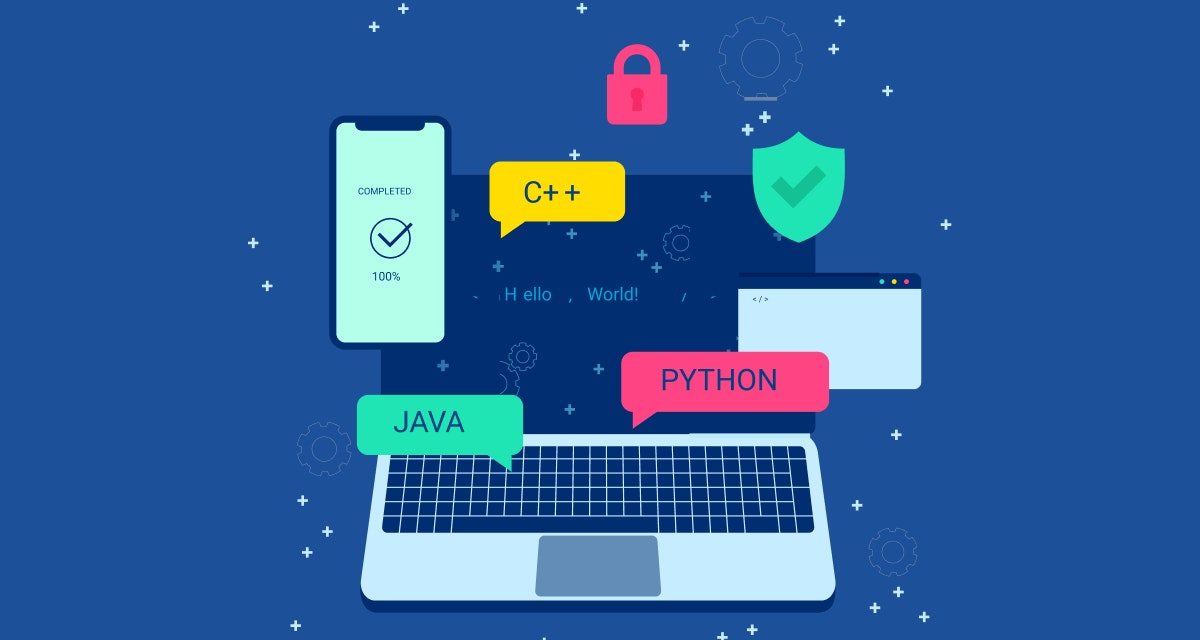It is 2021, and it is safe to say that the world has finally arrived at a point where Artificial Intelligence is no longer considered scary. In fact, AI has turned out to be useful in many business and personal aspects of our lives.
An increasing number of industries are adopting AI to solve urgent problems, alleviate consumer pain points faster, and drive digital transformations on a grander scale. AI is seen as a necessity rather than a luxury.
Of course, that makes AI programming powerful and intricate. Now you may want to develop an AI product for your business. But since you do not speak the technical language, picking the right programming language for AI can be a hassle.
1. Python
Python is one of the best AI programming languages because of its syntax simplicity and versatility. These qualities make it less complicated than Java and C++. Since it is such a dynamic language, Python allows you to focus on the core value of programming and problem-solving and creative thinking capabilities in applications.
It is also a portable language—apt for multiple platforms such as macOS, Windows, Linux, and UNIX. It supports functional, procedural, and object-oriented styles of programming. Unlike other AI programming languages that use punctuation, Python uses English keywords and is designed to be picked up by amateur developers quickly and easily.
Pros
- It has feature-rich tools and an extensive library.
- It supports algorithm testing and does not require any implementation.
- It is faster in development as compared to Java and C++ because of its modular and interactive structure.
- It supports neural networks and the development of NLP solutions due to its straightforward function library.
- It can easily be integrated with C++, C, Java, Cobra, and other languages.
Cons
- Developers accustomed to Python may find it challenging to switch to other AI programming languages.
- It is not suitable for mobile computing because of its weak language.
Use cases
Python's usage is not limited to building enterprise applications. It is also useful for making smaller scripts. When it comes to scalability, it offers better support for large enterprise programs than simple shell scripts.
Standard libraries
Matplotlib, Numpy, Pybrain, Pandas, Scipy, and Scikit-Learn are the five most essential Python libraries.
2. Rust
A systems-level programming language, Rust, was created to write a safe codebase — wherein the developers can manage the objects in the AI program itself. This alleviates the problem of having to manage memory and doing pointer arithmetic separately. It is a language that empowers everyone to build reliable and efficient software.
Rust has been picked as the "most loved programming language" by Stack Overflow's annual developer surveys — four times in a row.
No wonder it is one of the top 5 AI programming languages for developers who want to provide memory safety in their software solutions without garbage collection.
Currently used by the likes of npm and Yelp!, Rust enables you to eliminate many bugs classes at compile-time. Project Venona, the newly open-sourced research programming language, uses the Rust principles to maintain legacy C and C++ codebases safely.
It also has excellent documentation for its smart multi-editor, and auto-formatting feature, and auto-completion features.
Pros
- It is safe, secure, and efficient.
- It is memory-efficient and fast.
- It ensures a cleaner codebase for the developers to expand.
- It enables pattern-matching.
Cons
- It includes a slower compiler than other languages.
- Developers may take longer to learn Rust because it is complicated as compared to Python and other languages.
Use cases
Rust is used to create a range of software applications such as operating systems, browse components, game engines, and simulators for VR.
Standard libraries
serde, clap, Rayon, hyper, proptest, and Actix are some of the most preferred libraries of Rust that developers enjoy using.
3. Java
Java is the most widely used programming language used globally. It is also one of the best choices for AI programming. Thanks to Virtual Machine Technology, Java is easy to implement on various platforms after only writing and compiling it for one platform—it runs on the WORA [Once Written Read/Run Anywhere] principle.
Java offers many benefits, such as simplified work with large-scale projects, better user interaction, and graphical data representation. It also incorporates SWT [Standard Widget Toolkit] and Swing to make the app interface more sophisticated and appealing.
Pros
- It is portable, and unlike C++, it is easy to use and debug.
- It has an automatic memory manager that eases the work of the developer.
- It is a multi-paradigm language that follows object-oriented principles.
- It is apt for NLP and neural networks.
- It is platform-independent.
- It can be easily picked up by amateur AI developers because it is easy-to-learn.
Cons
- It has less speed in execution and has a longer response time.
- It requires dramatic changes in hardware and software to facilitate.
- It is considered an immature AI programming language as it lacks agility.
Use cases
Java is used to develop games, e.g., Minecraft. Java has enabled AI in web development and engineered branded websites such as Google and LinkedIn.
Standard libraries
JHipster, Apache Commons, Maven, google-gson, Mockito, JUnit, and Hibernate-ORM are some of the Java libraries used by developers.
4. Prolog
Prolog is one of the oldest programming languages globally and means "programming in logic." It was developed by Alain Colmerauer, a French scientist, in the 1970s. Given the number of iterations it has undergone, makes it suitable for AI projects.
Comprising mechanisms such as tree-based data structuring, automatic backtracking, and pattern matching, Prolog facilitates flexible frameworks. It is also a declarative and rule-based language that contains facts dictating the AI codebase.
Meaning, after the developer has specified the facts, rules, and the end goal, Prolog will try to find the connection between the three. Being a logical programmer is not everyone's cup of tea, but those who are, tend to think about problems logically rather than procedurally.
Pros
- It enables you to create a database along with running the AI program.
- It uses the predictive calculus language.
- It is a fully object-oriented programming language.
- It supports direct linking with C and C++.
- It has a built-in capability to handle lists.
Cons
- Despite being an old language, it is not fully standardized and hence, sometimes makes the implementation process cumbersome.
Use cases
Apart from its use in AI projects, it is also used for creating medical systems.
Standard libraries
CLP(B), clpqr, iostream and optparse are some of the niche Prolog libraries in use.
5. C++
Developed by Danish computer scientist Bjarne Stroustrup in 1983, C++ is ideal for handling AI projects. It has a complex syntax, so it might not be your first choice for any AI projects. However, C++ is perfect when working in an embedded environment.
C++ is also appropriate for neural networks and machine learning. It supports the reuse of development programs due to data-hiding and inheritance. This equivocally helps businesses save time and overhead expenses in their AI projects.
Pros
- It has better efficiency of control because of the extensive use of algorithms.
- It provides faster execution, and its speed is very much appreciated for time-sensitive AI programming projects.
- It is ideal for handling complicated AI problems.
- It supports object-oriented principles, which makes it useful for data organization.
Cons
- The standard library of C++ is small.
- Large C++ projects are hard to maintain and are time-consuming to build.
- It does not allow developers to multitask as it is only suitable for implementing the core of specific systems and algorithms.
- The learning curve is too steep for beginners.
Use cases
For example, search engines such as Google, Yahoo!, and Bing deploy C++ to reduce the time taken to fetch search results. The language is also used in building computer games because of its AI capabilities.
Standard libraries
The Standard C++ library comprises many components such as diagnostics, general utilities, language support, standard numerics, localization classes and templates, and so on.
6. LISP
Developed by American computer scientist John McCarthy in 1955, LISP is a safe programming language for AI projects. It is also the second oldest language after Fortran. Over time, Lisp has developed into a dynamic and robust coding language.
Unlike other AI programming languages, it is more efficient in problem-solving and adapts to the developers' needs rather swiftly.
Pros
- It is flexible and extremely fast in prototyping because compilers and not interpreters support it.
- It has a unique macro system that facilitates the implementation of different levels of AI.
- It is highly suitable for inductive logic and machine learning projects.
- Lisp AI programs are smaller and that is what makes them easier to maintain.
Cons
- Not all developers are equipped with the knowledge of Lisp programming. In fact, the number is relatively low in the market.
- Developers can only use it after new hardware and software have been configured.
Use cases
It can be used in creating any application or in any niche - business systems, simulations, web servers, signal processing, credit card systems, and so on.
Standard libraries
Common-Lisp.net, The Common Lisp Open Code Collection [CLOCC], and Click are some of the niche Lisp libraries in use.
7. R
R is one of the most influential AI programming languages. It is primarily used for analyzing and manipulating the data for statistical purposes. With the help of R, you can quickly produce a well-designed, high-quality plot that includes mathematical formulae and symbols.
Since it is a general-purpose language, R comes with numerous packages such as Gmodels, Tm, Class, and RODBC — all of which come in handy in developing machine learning projects. These packages implement ML algorithms quickly and help crack business associated problems.
Pros
- It is relatively easy-to-understand and -use for data-centric tasks because of the abundance of packages and materials.
- It is particularly good at crunching numbers (or dealing with statistical data) and is often considered a better choice for the same than Python.
Cons
- It consumes the memory space excessively.
- It lacks the necessary infrastructure for security — which means it cannot embed into web applications.
- It is still rooted in S, an older programming language.
Use cases
The most common uses of R are Big Data modeling, data visualization, and data analysis. From data mining and advanced data analysis — Julia helps in many particular data-related tasks.
Standard libraries
DBI, odbc, RMySQL, tidyr, ggplot2, rgl, and htmlwidgets are a few popular R libraries used for data mining, manipulation, and visualization.
8. Scala
As the name suggests, Scala is scalable and can handle large volumes of data efficiently. It is multi-paradigm, which means it supports both functional and object-oriented programming styles. It has a concise codebase — making it more readable and more comfortable to write than other programming languages such as Java.
Pros
- Its codebase is relatively error-free, and if needed, the debugging process is more straightforward.
- It is speedy and efficient — making it a hot favorite for AI for app development.
- It leads to higher productivity because of not having to write repetitive boilerplate. That means faster time-to-market.
Cons
- Since Scala supports both programming styles, it makes understanding type-information difficult.
- It runs on JVM, which means there is a lack of tail-recursive optimization.
- It is a relatively new language in the AI domain, so not apt for complex AI projects.
Use cases
It is ideal for projects that require versatility, from building big data pipelines and hundreds of microservices to ad-serving back-end services.
Standard libraries
The scala package contains core types such as Float, Int, Option, and Array. There are other tools such as DeepLearning4j and ScalaNLP that facilitate the AI development process with Scala.
9. Julia
Developed by MIT, Julia is apt for AI projects wherein the tasks require high-performance numerical computing and analysis. That means, with the help of this safe programming language, you can get instant results without requiring any separate compilation.
It is efficient and dynamic and can be used to write any application because of its “general-purpose” nature. It also offers other features such as metaprogramming, profiling, logging, package management, asynchronous I/O.
Julia is supported by wrappers such as Mocha and TensorFlow.Jl both of which are minimal maintenance codebases. It also reduces and saves costs by combining the familiar syntax and easy languages such as R, Python, and C++ — this is a fantastic feature of Julia.
Pros
- It comes with multiple dispatch capabilities.
- It is an open-source programming language from MIT — which means heightened credibility.
- It has an automatic memory management system.
- It offers superior parallelism.
Cons
- Unlike other programming languages, it is not supported by a growing community.
- Developers do not have a wealth of debugging tools at their disposal.
Use cases
One of the USPs of Julia is that it can translate algorithms from research papers into a codebase without any loss. This significantly improves safety and reduces model risk.
Standard libraries
Julia has a wealth of libraries for different tasks: Indexable Collections, Strings, Standard Numeric Types, Sparse Matrices, and Combinatorics.
10. Haskell
Haskell is a statistically-typed and general-purpose functional programming language developed in the 1990s with flexible semantics — based on the Miranda programming language. It initially gained popularity in academic circles but slowly found its way in Google and Facebook projects.
Haskel specifically supports embedded domain languages that play a considerable role in AI and programming language research. It can be integrated with many tools such as DataDog, Equinix Metal, Status.io, DreamHost, and WebMon.
Pros
- It allows expressive and efficient libraries for creating AI algorithms.
- It is apt for engaging in abstract maths, unlike Java, and leverage common algebraic structures such as monoids and modules.
- It enables developers to quickly spot errors in the app during the compile phase of the iteration.
- It is cost-efficient and time-saving.
Cons
- It is not a popular programming language in enterprise environments.
- It lacks the same level of support enjoyed by the likes of Python and Java.
Use cases
Typically, Haskell is used for developing small domain-specific languages. Other projects where it works efficiently are creating web spiders and high-volume data processing.
Standard libraries
Since Haskell is open-source, its community is very active and keeps developing a range of packages available publicly. QuickCheck, async, XML, and Cairo are some of the Haskell libraries available.
11. JavaScript
Fans of Java will love JavaScript. After all, it is the former’s more versatile cousin. JavaScript is a multi-paradigm dynamic programming language whose syntax is based on both C and Java.
JavaScript supports object-oriented programming as well as functional programming. Since functions are objects, they can be stored in variables and passed around like any object in this AI programming language.
JavaScript also features TensorFlow, one of the most popular frameworks for deep learning, making it ideal for AI applications. It is a core open-source library for building training ML models. Get started with the same by running Colab notebooks directly into your browser.
Pros
- It is highly efficient and easy to use.
- It supports both back-end and front-end development.
- It includes rich interfaces for a high degree of customization.
- It is highly interoperable with other programming languages.
- It has fewer overheads in the code, making it a cleaner language to write.
- It is an interpreted language, which reduces the time required for compilation and execution.
Cons
- It has a less efficient debugging system.
- It is not as popular or well-understood as Java.
- Its low client-side security as code is visible to the end-user.
- It supports only single inheritance and not multiple inheritance.
Use cases
So far, JavaScript has been commonly used in a range of AI projects, including facial and emotion detection, image style transfer (photo editing apps and customizing themes), and person segmentation (which allows highlighting and cropping out some aspects in a video or photo). The capabilities are only to be expected over time.
Standard libraries
jQuery, Parsley, QUnit, AngularJS, and Ember.js are the five most essential JavaScript libraries.
12. Kotlin
Kotlin is a programming language that runs on Java Virtual Language. Since its creation in 2011, Kotlin has gained a lot of popularity among developers and was supported by Google in 2017 to create Android applications.
Kotlin employs a type of combative assumption to determine the type of definition and values needed if these are not illustrated suitably. This gives it an advantage over Java, requiring monotonous stipulations.
Pros
- It is interoperable with Java codes.
- It combines functional and procedural programming.
- Therefore, it is supported by multiple IDEs and is easy to maintain.
- It is highly reliable and easy to write, thus enabling more productivity.
- It has an easy learning curve — even amateur developers can learn to use this language swiftly.
Cons
- It is not easy to find too many expert developers
- There are limited sources in the market to learn Kotlin from.
Use cases
Since Kotlin is a modern, general-purpose programming language, it has full compatibility with Java, which makes it an appealing language for web development, Android development, AI development, and so on.
Standard libraries
The Kotlin standard library is compact but replaces several Java libraries that are much larger once you have no use of them in Java. Anko Commons, Anko SQLite, and Anko Coroutines are some of the standard libraries of Kotlin.
13. Wolfram
Wolfram, part of the initial 1988 version of Mathematica, is a multi-paradigm functional programming language.
It was developed by Stephen Wolfram of Wolfram Research and has brought its robust, high-speed computation to many development projects such as Wolfram One, Wolfram Alpha, Mathematica, and MockMMA.
The syntax of Wolfram is similar to the M-expression of 1960s LISP. Owing to its ability to perform natural language processing functions and advanced calculations, Wolfram is widely used as a computer algebraic language.
It comes with over 6000 built-in functions that can be used for rule-based programming, functional programming, and symbolic computation and can also use arbitrary structures and data during development.
Pros
- It saves time and has an exact search engine.
- It can support complex applications like 3D modeling.
- It has a simple user interface with several mobile versions available.
- It comes with a well-integrated suite of tools and ensures constant updates in data curation.
- It uses infix operators to write essential arithmetic functions and supports currying and pattern matching.
Cons
- It supports only the English language.
- It is expensive for non-enterprise users.
- Queries need to be highly specific to get an accurate answer.
- Its official implementation is closed-source, which means one must purchase it to tap into its full potential.
Use cases
Thanks to Wolfram, it is possible to deliver highly interactive reports, notebooks, and software with a spectrum of interfaces for enabling modern decision-making in organizations.
Standard libraries
Wolfram is more popular as a computer algebraic language because of its NLP functions. The Wolfram LibraryLink allows dynamic libraries to be directly loaded into the kernel to exchange reals, strings, packed arrays, and integers.
14. Smalltalk
Smalltalk is one of the most influential programming languages, with Java, Ruby, and Python taking inspiration.
It, in fact, was the first graphical language tool that enabled code changes and advanced debugging in a user-friendly fashion. It is one of the popular choices for software design patterns, rapid application development, and agile software development.
In addition, several Smalltalk libraries are being used for applications like natural language processing, generic algorithms, image processing, neural networks, and so on.
Pros
- It is ideal as a ‘teaching language.’
- It has a live coding and debugging capability.
- Smalltalk has a strong community across the globe that is growing consistently in AI.
- It is an object-oriented, dynamically typed reflective language that has a large number of variants.
Cons
- It is used mainly for hobby projects.
- It is not as popular as languages like Python or R.
- It cannot apply knowledge of languages like C++ or Java.
Use cases
Smalltalk can be used for making chatbots for engaging end-users. It builds interactions with the bot and, in turn, aids in improving the recall rates. Given how powerful chatbots are in optimizing customer satisfaction, Smalltalk is a boon for companies relying on conversations with the intended audience.
Standard libraries
Many libraries are deployed for neural networks, image processing, NLP, and generic algorithms. Aida, Algernon, Croquet, Etoys, Immersive Terf, Magma, Newspeak, OLPC, and so on are some of the standard libraries of Smalltalk.
Wrapping it up
The choice of programming languages for AI projects depends on many factors, including:
- Your business specifics
- Your market or industry conditions
- Your target audience
- The problems you are trying to alleviate through the app
- Your budget and timescales — if it is time-bound, you need to use a language that delivers a faster turnaround.
At Intuz, we believe every project is unique, which is why our experts always give recommendations based on our clients’ requirements. Research is paramount before picking a suitable AI programming language.
If you are searching for help for your next AI project, please contact us, and we will save your time, money, and resources with our top-notch AI development services.






